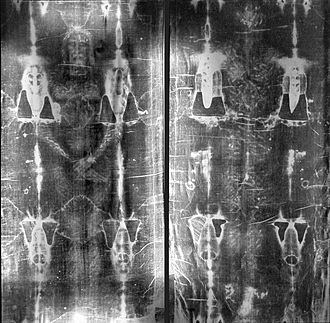Shroud of Turin
- Liveology

- Jun 5
- 2 min read
A linen cloth bearing the negative image of a man who appears to have been crucified, possibly the burial shroud of Jesus Christ himself.

The Shroud of Turin is a length of linen cloth bearing the faint image of a man who appears to have been crucified. It is traditionally believed by many to be the burial shroud of Jesus of Nazareth. Measuring approximately 14 feet long and 3.5 feet wide, the cloth displays front and back images of a man with wounds that correspond to those described in the New Testament—such as pierced wrists and feet, a wound in the side, and marks consistent with scourging. The shroud is currently housed in the Cathedral of Saint John the Baptist in Turin, Italy, and has been the subject of religious devotion, controversy, and scientific inquiry for centuries.
The authenticity of the Shroud of Turin has been hotly debated. In 1988, radiocarbon dating tests conducted by three independent laboratories dated the cloth to the Middle Ages, specifically between 1260 and 1390 CE, suggesting that it is not old enough to be the burial cloth of Jesus. However, critics of the carbon dating argue that the sample tested may have been taken from a portion of the cloth that had been repaired in the Middle Ages or contaminated over time. Additional studies have pointed to pollen grains, bloodstains, and historical records that could support the shroud’s presence in the Middle East earlier than the carbon dating suggests.

Some researchers and believers argue that the image on the shroud is miraculous or was formed by a burst of radiant energy at the moment of resurrection. They point to the unusual photographic qualities of the image, which became more visible in detail only when viewed in negative after being photographed in 1898. The image also shows no clear signs of pigment, which makes it different from known medieval forgeries. Scientific explanations have included natural chemical reactions, contact with bodily fluids, or environmental effects, but no conclusive method has been universally accepted to explain how the image was formed.
Skeptics maintain that the shroud is likely a medieval artifact, possibly created as a devotional object or relic during a time when the demand for such items was high. Some art historians have noted similarities between the shroud’s image and medieval artistic styles, suggesting that it could have been created intentionally to appear ancient and evoke reverence. Historical documentation of the shroud only becomes consistent around the 14th century, and earlier references to similar relics are inconclusive or disputed.
The Shroud of Turin remains an enduring mystery. For some, it is a powerful symbol of faith and a possible link to the physical presence of Jesus Christ. For others, it is a fascinating historical artifact that reveals more about medieval religiosity than ancient history. Whether real or not, its spiritual and cultural impact is undeniable.
Liveology® creates uplifting content and products for abundant life. Shop our all natural bodycare, handmade products, and spiritual apparel! Create a free account for access to our wealth of articles and videos on spirituality and victorious living. Thank you for your continued and growing support all over the world. Wishing you abundant life, love, joy, peace, and prosperity.




























































Comments